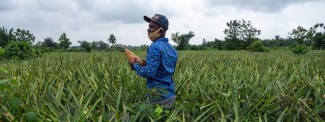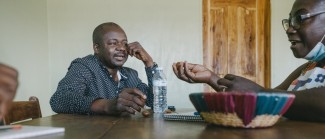Like many patients dealing with long-Covid, the road to recovery from the pandemic for low-income countries is long and arduous, but it is not insurmountable.
As the worst effects of Covid-19 begin to wear off, the World Bank has warned that output in emerging and developing countries will remain substantially below pre-pandemic levels in the near future.
Uneven growth forecasted
Global growth rebounded to 5.5% in 2021 – the strongest post-recession pace in 80 years – as easing of pandemic-related restrictions unlocked pent-up demand. However, it is expected to slow to 4.4% in 2022 and to 3.2% next year due to weakening demand, the risk of new variants emerging, and supply bottlenecks, the Bank said in a new report.
Richer countries are projected to bounce back faster and the Bank warned that recovery will be slower in low-income countries, especially small, fragile and conflict-affected states. This is due to lower vaccination rates, tighter fiscal and monetary policies, and more persistent scarring from the pandemic.
Growth in low-income countries rose to 3.3% in 2021 but domestic demand remains subdued due to job losses from Covid-19, limited resources by governments to support incomes, and conflict in Ethiopia, Afghanistan, Burkina Faso and other countries.
LDC economies' reliance on commodities hurts recovery
The economies of LDCs are projected to grow at a higher rate of 4.9% in 2022 on the back of higher commodity prices and recoveries in agriculture and mining – but this is below the annual average growth rate of 5.5% seen between 2000 and 2019.
Recovery is expected to strengthen in 2023, with growth rising to 5.9% but many LDCs remain reliant on extractive industries and are vulnerable to volatile commodity prices.
Even if the recovery holds, the effects of the pandemic will linger for many years. At least one in two economies in East Asia and Pacific, Latin America and the Caribbean, Middle East and North Africa, and two out of every five economies in sub-Saharan Africa will still be below their 2019 per capita GDP levels by 2023, the World Bank report notes. If travel restrictions persist the economies of low-income countries reliant on tourism could remain under water for even longer.
Per capita incomes in half of all LDCs are forecast to remain below pre-pandemic levels in 2022. Worst-hit are fragile and conflict-affected countries.
After the stand-still in 2020, last year saw many sharp movements. Commodity prices rose due to pent-up demand, with agricultural prices rising 23% on average, boosted by record-high imports from China and weather-induced supply disruptions. Global trade grew at 9.5% and shipping prices rose sharply – at their peak in October 2021 they were six times their 2019 levels.
But the outlook remains uncertain. After rising briskly in early 2021, global trade has plateaued due to weakening demand for traded goods and supply chain bottlenecks.
Growth in global trade is expected to slow to 5.8% in 2022 and 4.7% next year as demand moderates. The World Bank report highlights the risk of worsening supply bottlenecks in the short-term, and rising protectionism in the long-term.
Already industrial production in emerging market and developing economies has slowed and new manufacturing orders for export remain subdued as external demand weakens and route-to-market bottlenecks linger.
Trade financing and investments to drive recovery efforts
The World Bank report makes broad recommendations for low-income countries to consider in order to build back better, faster, and stronger. One is to expand access and speed up vaccination to reduce vulnerability to Covid-19 and any new variants that might emerge. This needs to be matched by efforts to reverse sharp increases in poverty and food insecurity in some of the worst-affected countries.
Emerging market and developing economies need to reduce their reliance on commodity exports by diversifying their export and national asset portfolios.
Countries need to reprioritise their public spending and subsidy schemes and undertake measures to expand the tax base.
In addition, low-income countries need policy measures to facilitate cross-border trade and investment which, combined with reforms “to improve business climates, human and physical capital, can help these countries generate the productivity growth needed to catch up to advanced-economy per capita incomes”, the Bank notes.
LDCs will also need help from the outside. In 2022, low-income countries are expected to pay $35 billion to service bilateral and private-market debt. Any debt-relief initiatives will free up resources for investment in rebuilding the economies.
Inversely, many LDCs lack access to international financing markets, despite generally favourable conditions. Exploring trade financing opportunities to reduce the cost of doing business and boost exports will speed up recovery.
Like many patients dealing with long-Covid, the road to recovery from the pandemic for low-income countries is long and arduous, but it is not insurmountable.
If you would like to reuse any material published here, please let us know by sending an email to EIF Communications: eifcommunications@wto.org.



